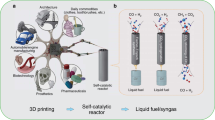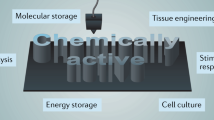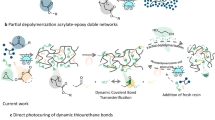Abstract
In recent decades, 3D printing (also known as additive manufacturing) techniques have moved beyond their traditional applications in the fields of industrial manufacturing and prototyping to increasingly find roles in scientific research contexts, such as synthetic chemistry. We present a general approach for the production of bespoke chemical reactors, termed reactionware, using two different approaches to extrusion-based 3D printing. This protocol describes the printing of an inert polypropylene (PP) architecture with the concurrent printing of soft material catalyst composites, using two different 3D printer setups. The steps of the PROCEDURE describe the design and preparation of a 3D digital model of the desired reactionware device and the preparation of this model for use with fused deposition modeling (FDM) type 3D printers. The protocol then further describes the preparation of composite catalyst–silicone materials for incorporation into the 3D-printed device and the steps required to fabricate a reactionware device. This combined approach allows versatility in the design and use of reactionware based on the specific needs of the experimental user. To illustrate this, we present a detailed procedure for the production of one such reactionware device that will result in the production of a sealed reactor capable of effecting a multistep organic synthesis. Depending on the design time of the 3D model, and including time for curing and drying of materials, this procedure can be completed in ∼3 d.
This is a preview of subscription content, access via your institution
Access options
Subscribe to this journal
Receive 12 print issues and online access
$259.00 per year
only $21.58 per issue
Buy this article
- Purchase on Springer Link
- Instant access to full article PDF
Prices may be subject to local taxes which are calculated during checkout










Similar content being viewed by others
References
Dimitrov, D., Schreve, K. & de Beer, N. Advances in three dimensional printing – state of the art and future perspectives. Rapid Prototyping J. 12, 136–147 (2006).
Gibson, I., Rosen, D. & Stucker, B. Additive Manufacturing Technologies 2nd edn. (Springer-Verlag, 2015).
Rengier, F. et al. 3D printing based on imaging data: review of medical applications. Int. J. Comput. Assist. Radiol. Surg. 5, 335–341 (2010).
Li, X.M. et al. 3D-printed biopolymers for tissue engineering application. Int. J. Polym. Sci. 2014, 1–13 (2014).
Skoog, S.A., Goering, P.L. & Narayan, R.J. Stereolithography in tissue engineering. J. Mater. Sci. Mater. Med. 25, 845–856 (2014).
Hollister, S.J. Porous scaffold design for tissue engineering. Nat. Mater. 4, 518–524 (2005).
Barry, R.A. et al. Direct-write assembly of 3D hydrogel scaffolds for guided cell growth. Adv. Mater. 21, 2407–2410 (2009).
Hong, S. et al. 3D printing of highly stretchable and tough hydrogels into complex, cellularized structures. Adv. Mater. 27, 4035–4040 (2015).
Nakamura, M. et al. Biomatrices and biomaterials for future developments of bioprinting and biofabrication. Biofabrication 2, 014110 (2010).
Boland, T., Xu, T., Damon, B. & Cui, X. Application of inkjet printing to tissue engineering. Biotechnol. J. 1, 910–917 (2006).
Zhang, Y., Tse, C., Rouholamin, D. & Smith, P. Scaffolds for tissue engineering produced by inkjet printing. Cent. Eur. J. Eng. 2, 325–335 (2012).
Mohanty, S. et al. Fabrication of scalable and structured tissue engineering scaffolds using water dissolvable sacrificial 3D printed moulds. Mater. Sci. Eng. C 55, 569–578 (2015).
Kolesky, D.B. et al. 3D bioprinting of vascularized, heterogeneous cell-laden tissue constructs. Adv. Mater. 26, 3124–3130 (2014).
Mosadegh, B., Xiong, G., Dunham, S. & Min, J.K. Current progress in 3D printing for cardiovascular tissue engineering. Biomed. Mater. 10, 034002 (2015).
Habibovic, P. et al. Osteoconduction and osteoinduction of low-temperature 3D printed bioceramic implants. Biomaterials 29, 944–953 (2008).
Klammert, U. et al. Low temperature fabrication of magnesium phosphate cement scaffolds by 3D powder printing. J. Mater. Sci. Mater. Med. 21, 2947–2953 (2010).
Ley, S.V., Fitzpatrick, D.E., Ingham, R.J. & Myers, R.M. Organic synthesis: march of the machines. Angew. Chem. Int. Ed. 54, 3449–3464 (2015).
Gross, B.C., Erkal, J.L., Lockwood, S.Y., Chen, C. & Spence, D.M. Evaluation of 3D printing and its potential impact on biotechnology and the chemical sciences. Anal. Chem. 86, 3240–3253 (2014).
Symes, M.D. et al. Integrated 3D-printed reactionware for chemical synthesis and analysis. Nat. Chem 4, 349–354 (2012).
Kitson, P.J., Symes, M.D., Dragone, V. & Cronin, L. Combining 3D printing and liquid handling to produce user-friendly reactionware for chemical synthesis and purification. Chem. Sci. 4, 3099–3103 (2013).
Jakus, A.E. et al. Three-dimensional printing of high-content graphene scaffolds for electronic and biomedical applications. ACS Nano 9, 4636–4648 (2015).
Lewis, J.A. Direct ink writing of 3D functional materials. Adv. Funct. Mater. 16, 2193–2204 (2006).
Kong, Y.L. et al. 3D printed quantum dot light-emitting diodes. Nano Lett. 14, 7017–7023 (2014).
Austin-Morgan, T. 3D printing of optical fibre. New Electron. 48, 8 (2015).
Pham, D.T. & Gault, R.S. A comparison of rapid prototyping technologies. Int. J. Mach. Tools Manuf. 38, 1257–1287 (1998).
Wang, X. et al. i3DP, a robust 3D printing approach enabling genetic post-printing surface modification. Chem. Commun. 49, 10064–10066 (2013).
Xing, J.-F., Zheng, M.-L. & Duan, X.-M. Two-photon polymerization microfabrication of hydrogels: an advanced 3D printing technology for tissue engineering and drug delivery. Chem. Soc. Rev. 44, 5031–5039 (2015).
Tumbleston, J.R. et al. Continuous liquid interface production of 3D objects. Science 347, 1349–1352 (2015).
Park, S.H., Yang, D.Y. & Lee, K.S. Two-photon stereolithography for realizing ultraprecise three-dimensional nano/microdevices. Laser Photon. Rev. 3, 1–11 (2009).
Wallace, D. in Inkjet-based Micromanufacturing Vol. 9 Advanced Micro and Nanosystems (eds. Korvink, J.G., Smith, P.J. & Shin, D.-Y.) 1–14 (Wiley-VCH, 2012).
Shirazi, S.F.S. et al. A review on powder-based additive manufacturing for tissue engineering: selective laser sintering and inkjet 3D printing. Sci. Technol. Adv. Mater. 16, 20 (2015).
Lee, K. et al. 3D-printed alginate/phenamil composite scaffolds constituted with microsized core-shell struts for hard tissue regeneration. RSC Adv. 5, 29335–29345 (2015).
Mironov, V., Boland, T., Trusk, T., Forgacs, G. & Markwald, R.R. Organ printing: computer-aided jet-based 3D tissue engineering. Trends Biotechnol. 21, 157–161 (2003).
Dorey, E. Process technology 3D printing for drugs. Chem. Ind. 78, 7 (2014).
Icten, E., Giridhar, A., Taylor, L.S., Nagy, Z.K. & Reklaitis, G.V. Dropwise additive manufacturing of pharmaceutical products for melt-based dosage forms. J. Pharm. Sci. 104, 1641–1649 (2015).
Kumar, S. Selective laser sintering: a qualitative and objective approach. JOM J. Miner. Met. Mater. Soc. 55, 43–47 (2003).
Agarwala, M., Bourell, D., Beaman, J., Marcus, H. & Barlow, J. Direct selective laser sintering of metals. Rapid Prototyping J. 1, 26–36 (1995).
Fischer, P. et al. Sintering of commercially pure titanium powder with a Nd: YAG laser source. Acta Mater. 51, 1651–1662 (2003).
Wang, F.L., Yi, C.Y., Wang, T., Yang, S.Z. & Zhao, G. A generating method for digital gear tooth surfaces. Int. J. Adv. Manuf. Technol. 28, 474–485 (2006).
Capel, A.J. et al. Design and additive manufacture for flow chemistry. Lab Chip 13, 4583–4590 (2013).
Hwang, Y.H., Paydar, O.H. & Candler, R.N. 3D printed molds for non-planar PDMS microfluidic channels. Sens. Actuat. A Phys. 226, 137–142 (2015).
Mathieson, J.S., Rosnes, M.H., Sans, V., Kitson, P.J. & Cronin, L. Continuous parallel ESI-MS analysis of reactions carried out in a bespoke 3D printed device. Beilstein J. Nanotechnol. 4, 285–291 (2013).
Dragone, V., Sans, V., Rosnes, M.H., Kitson, P.J. & Cronin, L. 3D-printed devices for continuous-flow organic chemistry. Beilstein J. Org. Chem. 9, 951–959 (2013).
Kitson, P.J., Rosnes, M.H., Sans, V., Dragone, V. & Cronin, L. Configurable 3D-printed millifluidic and microfluidic 'lab on a chip' reactionware devices. Lab Chip 12, 3267–3271 (2012).
Lee, M.P. et al. Development of a 3D printer using scanning projection stereolithography. Sci. Rep. 5, 9875 (2015).
Campbell, T.A. & Ivanova, O.S. 3D printing of multifunctional nanocomposites. Nano Today 8, 119–120 (2013).
Guo, S.-Z., Yang, X., Heuzey, M.-C. & Therriault, D. 3D printing of a multifunctional nanocomposite helical liquid sensor. Nanoscale 7, 6451–6456 (2015).
Kim, J.H. et al. 3D printing of reduced graphene oxide nanowires. Adv. Mater. 27, 157–161 (2015).
Peterson, G.I., Larsen, M.B., Ganter, M.A., Storti, D.W. & Boydston, A.J. 3D-printed mechanochromic materials. ACS Appl. Mater. Interfaces 7, 577–583 (2015).
Postiglione, G., Natale, G., Griffini, G., Levi, M. & Turri, S. Conductive 3D microstructures by direct 3D printing of polymer/carbon nanotube nanocomposites via liquid deposition modeling. Compos. A Appl. Sci. Manuf. 76, 110–114 (2015).
Visser, C.W. et al. Toward 3D printing of pure metals by laser-induced forward transfer. Adv. Mater. 27, 4087–4092 (2015).
Wei, X. et al. 3D printable graphene composite. Sci. Rep. 5, 11181 (2015).
Malone, E. et al. Freeform fabrication of zinc-air batteries and electromechanical assemblies. Rapid Prototyping J. 10, 58–69 (2004).
Ferrari, S. et al. Latest advances in the manufacturing of 3D rechargeable lithium microbatteries. J. Power Sources 286, 25–46 (2015).
Trimmer, B., Lewis, J.A., Shepherd, R.F. & Lipson, H. 3D printing soft materials: what is possible? Soft Robot. 2, 3–6 (2015).
Ilievski, F., Mazzeo, A.D., Shepherd, R.F., Chen, X. & Whitesides, G.M. Soft robotics for chemists. Angew. Chem. Int. Ed. 50, 1890–1895 (2011).
Melin, J. & Quake, S.R. in Annual Review of Biophysics and Biomolecular Structure. Vol. 36 Annual Review of Biophysics 213–231 (Annual Reviews, 2007).
Kitson, P.J., Marshall, R.J., Long, D., Forgan, R.S. & Cronin, L. 3D printed high-throughput hydrothermal reactionware for discovery, optimization, and scale-up. Angew. Chem. Int. Ed. 53, 12723–12728 (2014).
Loiseau, T. et al. MIL-96, a porous aluminum trimesate 3D structure constructed from a hexagonal network of 18-membered rings and μ3-oxo-centered trinuclear units. J. Am. Chem. Soc. 128, 10223–10230 (2006).
Acknowledgements
We gratefully acknowledge financial support from the EPSRC (grants EP/L023652/1, EP/K038885/1, EP/H024107/1, EP/K023004/1, EP/K021966/1, EP/I033459/1, EP/J015156/1, EVOBLISS EC 611640, EVOPROG EC 610730 and MICREAGENTS EC 318671 to L.C.), the Fundamental Research Funds for the Central Universities project (grants buctrc201510 and buctrc201530 to Y.-F.S. and L.C.) and the Royal Society Wolfson Foundation for a Merit Award. We acknowledge the work of M.D. Symes, R.S. Forgan, V. Sans, M.H. Rosnes and V. Dragone for their contributions to the development of the applications of this protocol.
Author information
Authors and Affiliations
Contributions
P.J.K. designed and performed the experiments, analyzed data and wrote the paper with guidance from L.C.; S.G. contributed extensively to the editing of the paper and with expertise in 3D printing theory and practice; W.C. and C.-G.L., supervised by Y.-F.S., contributed to the generalization of the protocol; L.C. conceived the idea, supervised the project and designed the experiments.
Corresponding authors
Ethics declarations
Competing interests
L.C. is a director of, and owns some shares in, Cronin Group PLC, set up to commercialize new approaches to design, discovery and digitization in chemistry.
Supplementary information
Supplementary Text and Figures
Supplementary Discussion, Supplementary Data 2 (PDF 9313 kb)
Supplementary Data 1
3D CAD Model Files including; Montmorillonite composite.stl Pd composite.stl Reactionware PP srchitecture.stl Reactionware.dwg Reactionware PP architecture.bfb (ZIP 549 kb)
Rights and permissions
About this article
Cite this article
Kitson, P., Glatzel, S., Chen, W. et al. 3D printing of versatile reactionware for chemical synthesis. Nat Protoc 11, 920–936 (2016). https://doi.org/10.1038/nprot.2016.041
Published:
Issue Date:
DOI: https://doi.org/10.1038/nprot.2016.041
This article is cited by
-
3D printed hierarchical spinel monolithic catalysts for highly efficient semi-hydrogenation of acetylene
Nano Research (2022)
-
Advanced preparation method of monolithic catalyst carriers using 3D-printing technology
Progress in Additive Manufacturing (2022)
-
Current and future trends of additive manufacturing for chemistry applications: a review
Journal of Materials Science (2021)
-
Continuous-Flow Catalytic Degradation of Hexacyanoferrate Ion through Electron Transfer Induction in a 3D-Printed Flow Reactor
Journal of Materials Engineering and Performance (2021)
-
Metal 3D printing technology for functional integration of catalytic system
Nature Communications (2020)
Comments
By submitting a comment you agree to abide by our Terms and Community Guidelines. If you find something abusive or that does not comply with our terms or guidelines please flag it as inappropriate.



